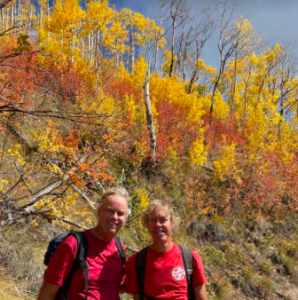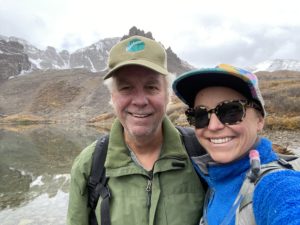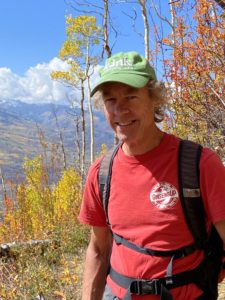In This Issue
-
Flanigan’s Eco-Logic: Fall in Aspen
-
Hertz Plans to Buy 100,000 Teslas
-
McKinsey Employee Concerns
-
The Greenest Colleges
-
Transcontinental Wind Delivery
-
The World’s Largest Battery
-
Microgrids: The EcoMotion Challenge
-
The NetPositive Podcast Updates

Flanigan’s Eco-Logic: Fall in Aspen
Two great hikes this time in the mountains of Colorado. The first to Cathedral Lake with daughter Skye. It’s a favorite of ours. The sky is a bit ominous. Big clouds. It’s been raining; there’s snow in the mountains. We rule out hiking to Electric Pass at 13,635 feet. That’s a high and dangerous altitude given this weather. The last days of fall.
Up Castle Creek through vibrant fall colors. Aspen trees in swaths of gold with flares of orange. Big mountains; rocky mountains. We turn-off just before the Pine Creek Cookhouse. The Cathedral Lake trailhead begins at 9,880 feet. We begin the “stiff hike” up the Pine Creek Valley, its creek tumbling down the mountain. My sea-level body struggles. I am not acclimated, huffing and puffing and taking many breaks, recharged by the views and majesty of the mountains. We look up to massive avalanche chutes.
Strenuous it is, but soon enough we’re heading up the trail’s signature switchbacks. That means we’re near the lake. It’s a steep pitch. The switchbacks are short, up a narrow incline. There are rock walls on either side. After the last switchback, we crest. There are clumps of snow on the ground. It’s chilly in shorts. As we near the lake it begins to snow. A flurry!

Cathedral Lake is nestled in a dramatic cirque beneath rugged peaks. The lake is at 11,866 feet. The serenity of this huge body of water surrounded by soaring mountains is divine. We’ve got the lake to ourselves right now. We eat granola bars and take pictures. It’s a little too cold and wet to hang out. Another party arrives and hoots and hollers, echoes resound off the cirque that provides a cathedral of granite… sending sound waves back with remarkable clarity.

Sure is easy going down hill! We encourage others heading up. Back in our wheels, we follow the creek downvalley, admiring more fall colors. In town, we hot tub at the base of Tiehack, warming up, soothing the muscles, enjoying that great hiker’s feeling of accomplishment.

The next morning Skye and Jake and I head into town in two cars. Through town, past the post office, over the river and up, up, up the slopes of Red Mountain. We pass swanky homes with killer views. Higher and higher up until we’re on dirt roads and we work our way into the Hunter Creek Valley. There we drop a car at the end of our planned Sunnyside trail loop. We hit the farmers market for breakfast burritos and java.
Out of town on the west side, we head down Cemetery Lane, cross the bridge and head left up the McLain Flats Road. Parking on the left; trailhead to the right. We meet brother Bill and BFF Sardo and head up the trail. For the first miles it skirts west. As we rise, the views just get better… the town, the Maroon Bells, the hospital, high school, the busy airport.

Then we’re above all the Red Mountain houses. Starwood mesa further west, is well below us. The views of Aspen Mountain and the Maroon Bells are postcard perfect. The town of Aspen looks idyllic, nestled at 8,000 feet between Aspen Mountain and “our” mountain for the day, Red Mountain. Blue, blue skies with blustery white clouds. It’s just spectacular, the views unending and enchanted.

Surprised to run into someone that I know. Mike Tierney unicycles towards us. He’s a champion athlete. How can anyone unicycle on a rocky trail like this? Mike also runs Aspen Solar, the area’s leading solar thermal installer. The system he installed for me has been providing free radiant solar heat from three Novan panels for 30+ years. We talk shop.

Sunnyside sweeps west then climbs. We trek and traverse east through aspen forests and then scrub oaks in red fall color and then more aspens. The trail takes us near Red Mountain’s peak and then up and over and down toward Hunter Creek. We pass through a pine forest and feel the cold of its hollow. We now have views of the Sawatch Range, noted for its 14,439 foot Mount Elbert, the highest of Colorado’s 58 “fourteeners.”
On the Hunter Creek Valley floor we walk through fields of golden grasses. We take pictures of abandoned cabins, their corrugated roofing rusting but standing the test of time. Imagine living here, mining for silver, and hunting and fishing for sustenance. The car park appears in the distance. A good workout we’ve had; another successful hike. Lots of good discussions and perspective on the trail as always. The day has been both exhausting and refreshing. Thanks to Jake, Skye, Billy, and Sardo.

![]()
![]()
![]()
![]()

 Hertz rents cars at 12,000 locations in 160 countries. Hertz began leasing electric vehicles in 2011 but only in select markets for premium prices. This week, Hertz announced that it plans to buy 100,00 Teslas for its rental car fleet. The deal is worth ~$4.2 billion. The 100,000 Teslas will make EVs 20% of Hertz’s global fleet. And Hertz wants an option with Tesla to buy 100,000 more.
Hertz rents cars at 12,000 locations in 160 countries. Hertz began leasing electric vehicles in 2011 but only in select markets for premium prices. This week, Hertz announced that it plans to buy 100,00 Teslas for its rental car fleet. The deal is worth ~$4.2 billion. The 100,000 Teslas will make EVs 20% of Hertz’s global fleet. And Hertz wants an option with Tesla to buy 100,000 more. In what has been considered a revolt within the world’s most influential consulting firm, a letter signed by over 1,100 McKinsey employees called for change at the consulting firm. Why? It has been advising many of the most environmentally damaging companies in the world. In its prestigious 95-year history, McKinsey & Company has supported the world’s biggest polluters.
In what has been considered a revolt within the world’s most influential consulting firm, a letter signed by over 1,100 McKinsey employees called for change at the consulting firm. Why? It has been advising many of the most environmentally damaging companies in the world. In its prestigious 95-year history, McKinsey & Company has supported the world’s biggest polluters. The Princeton Review “Guide to Green Colleges,” 2022 Edition, profiles 420 colleges out of 835 colleges it surveyed. Questions cover more than 25 data points. Of the 420 schools selected, 391 are in the United States, 26 are in Canada, and there was one each from Ecuador, Egypt, and Greece. Note that The Princeton Review is based in New York City and is not affiliated with Princeton University.
The Princeton Review “Guide to Green Colleges,” 2022 Edition, profiles 420 colleges out of 835 colleges it surveyed. Questions cover more than 25 data points. Of the 420 schools selected, 391 are in the United States, 26 are in Canada, and there was one each from Ecuador, Egypt, and Greece. Note that The Princeton Review is based in New York City and is not affiliated with Princeton University. OK. Build solar and wind in Africa, and send it to England. Why not? Fully 10.5 GW of solar and wind will be built in Morocco over 579 square miles, and it will supply the United Kingdom with power via subsea cables. Long ones. In fact, the 1.8 GW high voltage direct current subsea cables will each be 2,361 miles long… the world’s longest. “They’ll follow the shallow water route from Morocco to the UK, past Portugal, Spain, and France,” reports ElecTrek.
OK. Build solar and wind in Africa, and send it to England. Why not? Fully 10.5 GW of solar and wind will be built in Morocco over 579 square miles, and it will supply the United Kingdom with power via subsea cables. Long ones. In fact, the 1.8 GW high voltage direct current subsea cables will each be 2,361 miles long… the world’s longest. “They’ll follow the shallow water route from Morocco to the UK, past Portugal, Spain, and France,” reports ElecTrek.
 This is the tenth in our ten-part series on microgrids. Let’s end up discussing the challenges and opportunities related to our current work building microgrids in California. Teaser… they must be carbon-free and fully financed!
This is the tenth in our ten-part series on microgrids. Let’s end up discussing the challenges and opportunities related to our current work building microgrids in California. Teaser… they must be carbon-free and fully financed!